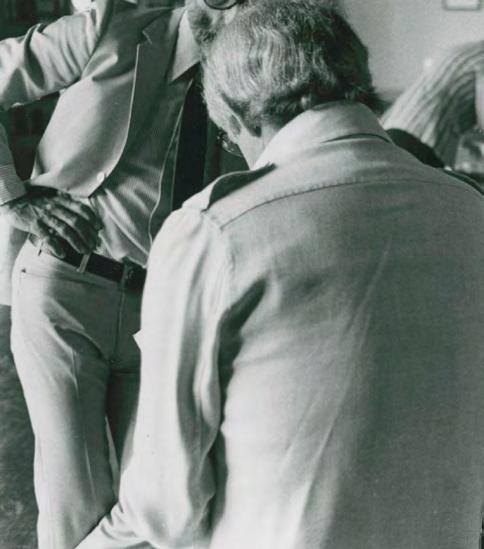DESIGN FOR THE FUTURE
 By Jayna Durfee
By Jayna Durfee
Muriel Cooper: a master of all things design. A designer of all things digital and print. A teacher of many and an inspiration to everyone, an American icon that’s done it all.
Cooper, born in Massachusetts in 1925, earned both a Bachelors of Arts degree and a Bachelors of Fine Arts degree in Design by the year 1948 at only 23 years old - and later earned a Bachelor of Science degree as well.1 Shortly thereafter, she began a career with the Massachusetts Institute of Design (MIT) that would span across four decades.
The remaining impact on MIT and the surrounding design world due to Cooper’s work is formidable even 25 years after her passing. Her start as a designer in the Office of Publications in 1952 lead her to be the first Director of Design at the MIT Press (the university press and media site affiliated with MIT) where she improved their production system and designed books at the same time. 2 However, her work in the MIT Press only came in 1967 after leaving the school in 1958 to partake in a scholarship abroad. Amid her time away from MIT, she also created her own design studio in her hometown of Boston, Massachusetts,
during which one of her biggest clients happened to be the MIT Press. 3 It is during this time that Cooper would create the iconic MIT Press logo: an abstract representation of the lowercase letters ‘mitp’ through seven vertical rectangles, reminiscent of books on a shelf. 4

Having met Paul Rand while living in New York earlier in her career, he recommended her to lead the MIT Press as the Design Director following her 9 year absence from the institution. 1
In 1974, Cooper began instructing a course on the “intersection of typography, graphic design, and technology” called ‘Messages and Means’. 3 She has been credited as one of the great innovators
5 Below: MIT Press colophon (logo) design process
5 Above: MIT Press final colophon (logo) design

of information presentation; “perhaps no one has had a greater affect on the way information — printed and electronic — is presented today than Muriel Cooper..her explorations into the interactions between technology and design broke new ground in both graphic design and computer interface development..”. 3
Cooper stated that one of her goals was to transform information into a form of communication. She viewed information on its own as lacking a “filter” that an innovative layout could bring. 3 While working on this mission, Muriel began to see the limits of print; when computers became more readily accessible, Cooper was able to explore the newfound depths and possibilities that this technology offered. Cooper was able to introduce computers to the designers at the MIT Press as well as be involved in the new course of ‘Computers and Design’ that
featured prominently in her design of the famous english-language version of Bauhaus: Weimar, Dessau, Berlin, Chicago, a project created for the 50th anniversary of the creation of the Bauhaus school. Her fresh yet familiar cover design and layout is still viewed as one of her most noteworthy pieces of work. Additionally, years later during her experimentation with newer technologies, Cooper made a 16mm film of the book. One frame was used for each spread and lasted only a little over a minute. This quick run-through of the book allowed the onlooker to gain an overall understanding of the layout and outline that is featured in most books. Sadly, the original film has since been lost; however, a former MIT Media Lab student has since recreated the film in honor of Cooper. 5
Although she left the MIT Press in 1975, Cooper continued her work with the institute as the cofounder of the MIT Visible Languages Workshop. This workshop strived to examine the intersection of computers, typography, and computer interfaces for personal devices. At the time of the Visible Languages Workshop’s creation, Cooper retained a part in the MIT Press as a Special Projects Director, showing her dedication to continue experimenting and educating all she could.
In 1985, about ten years

after the creation of the Visible Language Workshop, it would evolve into what is now the MIT Media Lab. This adaptation saw to a collaboration with other departments, though Cooper would remain the main professor. 5
Unfortunately in March of 1994 at the age of 68, Cooper passed away suddenly after a heart attack in Boston, Massachusetts. In her memory, a prize was created in
5 Above: Muriel Cooper, 1988
1997 at the Design Management Institute, just 3 years after her death, that aimed to honor those who “challenge our understanding and experience of interactive digital communication.”5
Muriel Cooper was and remains a pioneer in our understanding
*Below: Muriel Cooper at MIT, early 1970s
the complex intersection of communication, design, technology, and information. Her thirst for knowledge and creation never circumvented the people around her - it was always based on the idea that every person was needed to design a better world.

STAND AS A SKETCH FOR THE FUTURE
1“Muriel Cooper: Biography, Designs and Facts.” Famous Graphic Designers, www.famousgraphicdesigners.org/ muriel-cooper.

2Carlos, Dante. “Muriel Cooper: Turning Time into Space.” Walker Art Center, 9 Apr. 2014, walkerart.org/ magazine/muriel-cooper-turning-time-into-space.
3“Muriel Cooper.” ADC, ADC Global, adcglobal.org/hall-of-fame/muriel-cooper/.
4“Muriel” Pentagram, https://www.pentagram.com/work/muriel/story
5The MIT Press. “University Press Week: Throwback Thursday Featuring Muriel Cooper.” The MIT Press, The MIT Press, 13 Nov. 2014, mitpress.mit.edu/blog/university-press-week-throwback-thursday-featuringmuriel-cooper.
* Wiesenberger, Robert. “Muriel Cooper.” MIT Press, 28 Mar. 2018, https://mitpress.mit.edu/blog/murielcooper/.



















 Photo Credit: Marie Cosindas via MIT Media Lab on Medium
Photo Credit: Marie Cosindas via MIT Media Lab on Medium

 By Jayna Durfee
By Jayna Durfee




